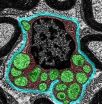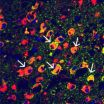A sausage a day is too many
2013-03-07
(Press-News.org) This press release is available in German.
"We estimate that three percent of all premature deaths can be attributed to the high consumption of processed meat," summarizes Sabine Rohrmann from the Institute of Social and Preventive Medicine at the University of Zurich. Teaming up with research colleagues from ten countries, she has been studying the link between the consumption of processed meat and the risk of mortality as part of a Europe-wide study with around 450,000 participants.
People who eat a lot of processed meat such as sausage products, salami or ham run a higher risk of dying from cardiovascular disease or cancer. The problem is that carcinogenic substances such as nitrosamines form through salting, pickling or smoking, and these might be the cause of the increase in cancer mortality. However, processed meats are also rich in cholesterol and saturated fats, which are linked to an increased risk of cardiovascular disease.
Consumption of processed meat one factor among many, but an important one
Other lifestyle and dietary factors influence the link between the consumption of processed meat and the risk of illness or mortality: for instance, vegetarians often live more healthily than non-vegetarians, do more sport and are less likely to smoke. This also goes for the present study: The participants who eat the most processed meat also eat fewer fruit and vegetables, consume more alcohol and smoke more. But even taking these factors into account in the evaluation of the data, the core result of the study still proves to be true: People who eat over 40 grams of processed meat per day have an increased risk of mortality compared to those who eat fewer than 20 grams a day.
Pain threshold 40 grams a day
However, meat also is a key source of important vitamins, especially B vitamins, and minerals such as iron: "Therefore, the moderate consumption of up to 40 grams a day doesn't increase the mortality risk," says first author Rohrmann, summing up the good news from the study.
###
Literature:
Sabine Rohrmann, et al. Meat consumption and mortality – results from the European Prospective Investigation into Cancer and Nutrition. BMC Medicine. March 2013. END
ELSE PRESS RELEASES FROM THIS DATE:
2013-03-07
Anyone whose hand or foot has "fallen asleep" has an idea of the numbness and tingling often experienced by people with peripheral nerve damage. The condition also can cause a range of other symptoms, including unrelenting pain, stinging, burning, itching and sensitivity to touch.
Although peripheral neuropathies afflict some 20 million Americans, their underlying causes are not completely understood. Much research has focused on the breakdown of cellular energy factories in nerve cells as a contributing factor.
Now, new research at Washington University School of Medicine ...
2013-03-07
RIVERSIDE, Calif. (http://www.ucr.edu) — A University of California, Riverside Bourns College of Engineering professor and a team of researchers published a paper today that shows how they solved an almost century-old problem that could further help downscale the size of electronic devices.
The work, led by Alexander A. Balandin, a professor of electrical engineering at UC Riverside, focused on the low-frequency electronic 1/f noise, also known as pink noise and flicker noise. It is a signal or process with a power spectral density inversely proportional to the frequency. ...
2013-03-07
Viruses often spread through the brain in patchwork patterns, infecting some cells but missing others. New research at Washington University School of Medicine in St. Louis helps explain why. The scientists showed that natural immune defenses that resist viral infection are turned on in some brain cells but switched off in others.
"The cells that a pathogen infects can be a major determinant of the seriousness of brain infections," says senior author Michael Diamond, MD, PhD, professor of medicine. "To understand the basis of disease, it is important to understand which ...
2013-03-07
The earthquake zones off of certain coasts—like those of Japan and Java—make them especially vulnerable to tsunamis, according to a new study. They can produce a focusing point that creates massive and devastating tsunamis that break the rules for how scientists used to think tsunamis work.
Until now, it was largely believed that the maximum tsunami height onshore could not exceed the depth of the seafloor. But new research shows that when focusing occurs, that scaling relationship breaks down and flooding can be up to 50 percent deeper with waves that do not lose height ...
2013-03-07
A research team at the University of Guelph has developed a new line of transgenic "Enviropigs." The new line of pigs is called the Cassie line, and it is known for passing genes on more reliably. The results of this project were published ahead of print in the Journal of Animal Science.
Enviropigs have genetically modified salivary glands, which help them digest phosphorus in feedstuffs and reduce phosphorus pollution in the environment. After developing the initial line of Enviropigs, researchers found that the line had certain genes that could be unstable during reproduction ...
2013-03-07
Wednesday, March 6, 2013, Cleveland: Concussions are the leading cause of brain damage in sports, particularly in football. However, researchers at Cleveland Clinic and the University of Rochester have found that football players may suffer long-term brain changes even in the absence of concussion.
In a study of 67 college football players, researchers found that the more hits to the head a player absorbed, the higher the levels of a particular brain protein that's known to leak into the bloodstream after a head injury. Even though none of the football players in the ...
2013-03-07
Scientists at A*STAR's Genome Institute of Singapore (GIS) have developed a novel technique to precisely monitor and study the evolution of micro-organisms such as viruses and bacteria. This is an extremely important capability as it allows scientists to investigate if new drugs designed to kill them are working, and catch the development of resistance early on.
Micro-organisms and cancer cells evolve more quickly than normal human cells as their rapid life-cycles enable faster selection of advantageous mutations. Previously, scientists have had to wait for the selection ...
2013-03-07
Flu viruses are a major cause of death and sickness around the world, and antiviral drugs currently do not protect the most seriously ill patients. A study published March 7th by Cell Press in the journal Cell reveals that a compound derived from fats found in fish oils prevents death in influenza-virus-infected mice, even at advanced stages of disease. The study offers a promising strategy for the treatment of patients with severe influenza virus infections.
"Given the potential for future lethal pandemics, effective drugs are needed for the treatment of severe influenza, ...
2013-03-07
When animals like dogs or rats sniff one another, there might be more going on than you'd think. Research reported in Current Biology, a Cell Press publication, on March 7th finds in rats that those sniffing behaviors communicate information about an individual's social status. In those encounters, more dominant rats act as primary sniffers, while subordinate sniffees actually slow their breath.
"We know that rats and other animals can communicate through vocalizations, physical contact, odors, and also visual displays," says Daniel Wesson of Case Western Reserve University. ...
2013-03-07
A new study explains how young brains are protected when nutrition is poor. The findings, published on March 7th in Cell Reports, a Cell Press publication, reveal a coping strategy for producing a fully functional, if smaller, brain. The discovery, which was made in larval flies, shows the brain as an incredibly adaptable organ and may have implications for understanding the developing human brain as well, the researchers say.
The key is a carefully timed developmental system that ultimately ensures neural diversity at the expense of neural numbers.
"In essence, this ...
LAST 30 PRESS RELEASES:
[Press-News.org] A sausage a day is too many


